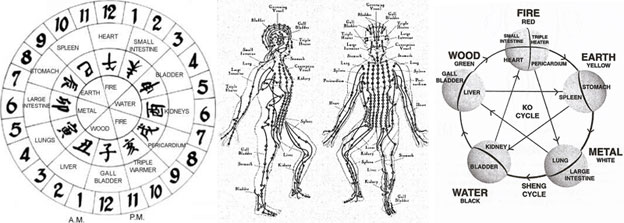
The Chinese practitioners, including the early wushu styles outside of Shaolin had combined qigong into their conditioning. Controlling the breath and the mind were the foundations for every fighting art. Breathing not only helped bring oxygen into the bloodstream for working muscles, but in many instances it could be used to help control fatigue or even shock from a serious injury. Martial arts schools and combat trainers often remind students that breathing is the key to any exercise. Whether the martial artist knew about qigong or not, they were very familiar with how important breathing was to survival. Qigong was said to help reverse illness, improve health and even increase life. It was rooted in the belief that there were meridians, or energy paths that flowed through the human body. Modern science might call these paths nerve clusters. Meridians were like roads that connected the energy systems that regulated the bodily functions. An interruption to any of the 12 major points, from an attack or accident could cause major illness, paralysis or death. Doctors that practiced acupuncture or acupressure could focus on the meridians that regulated bodily functions could help ease tension or improve health.
The meridians came up in popular media as pressure points. In martial arts movies and comics these were the places that a master could strike to knock down an opponent without hurting them. These were also the places, like the infamous 5 Palm Exploding Heart Technique from the Kill Bill movie, that masters could use to kill an opponent. In the more fantastic fables the pressure points could be used to paralyze or even brainwash people.
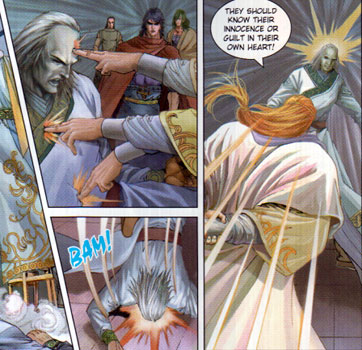
There was of course some scientific evidence to back up the concept of pressure points or meridians. Modern medicine had isolated the most vulnerable areas of the human body. These were places with major arteries or nerve clusters that were not protected by muscle or bone. An attack through the skin or cartilage to these locations could cause major damage to a vital organ. A hard strike to these spots could cause internal bleeding, an aneurism, heart attack or even death. A chart of the actual vital points and a chart of the 12 major meridians line up almost perfectly, giving some credibility to the ancient qigong practitioners.
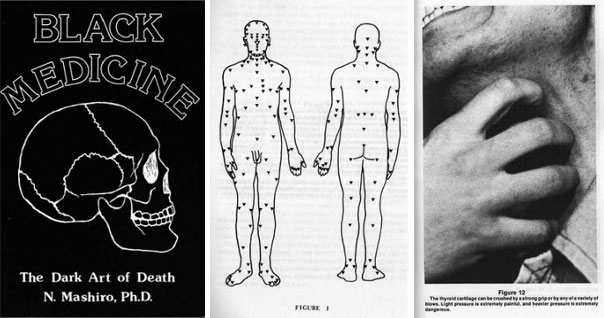 |
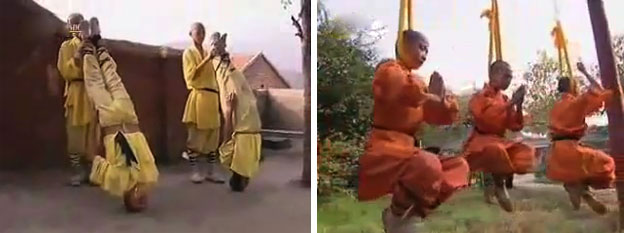
The devastating attacks of the Shaolin were second to the physical acts that they could perform. The monks practiced "hard" qigong which focused on strengthening the tendons, muscles and bones as well as "soft" qigong which focused on internal organs. After years of practice it was said that monks could gather chi and focus it on strengthening attacks or building impenetrable defenses. The Shaolin were able to perform amazing things that they credited through hard and soft qigong training and the gathering of chi. Most of the Shaolin monks started training at a very young age. Doing exercises and repeating forms over and over until they were second nature. What the West would consider extreme training was almost common in the Shaolin Quan. Take for example the “iron” techniques of iron head and iron neck. The exercises required to develop think skulls and strong neck muscles were brutal. Monks would practice standing on their heads on hard stone and hit their foreheads with thin bars of iron repeatedly. They would balance on their head and hit a sandbag with their head as well. This would create micro fractures in the skull which would be filled with calcium making the bones stronger and thicker. This would also result in developing very strong neck muscles. The same methodology of punching things over and over could be used to strengthen hands arms and legs. Strong concentration was required to develop an iron neck. Young monks would practice hanging themselves on ribbons or ropes. At first they would do this for a few seconds at a time but eventually they could support their own body weight for minutes at a time.
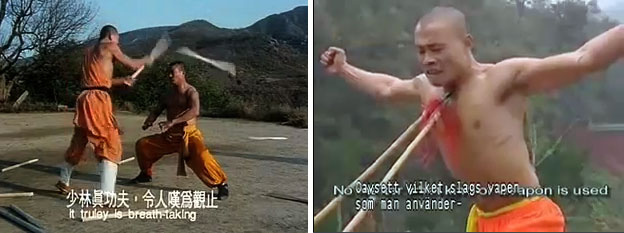
The end result for these training and exercises were bodies that were toughened to the point of being able to absorb tremendous amounts of energy without harming the practitioner. Wood and stone could be broken using every part of the body and sharp points were said to be incapable of breaking through skin and muscle. These were techniques that would have been invaluable during dynasty-era conflicts. When one dynasty fell and a new one took its place there was never a smooth transition. Every trace of the old dynasty was usually eradicated. Supporters were executed, art and literature destroyed and temples were burned. It was a violent affair and not even the Shaolin were exempt from this. As such the training techniques and methodologies were fiercely guarded and trusted only to a handful of masters for every generation. During several transitions the Shaolin had to go into hiding as entire schools of students and teachers could captured and executed. In some cases the monks were invited as guests to a banquet and then poisoned by the new regime. During the cultural revolution of the mid-20th century the Shaolin were almost wiped out again because of the mandate against religious organizations in the newly formed People's Republic of China. The level of secrecy that the Shaolin masters kept to themselves made for great fiction in martial arts stories or Wuxia, the stories of martial arts heroes.
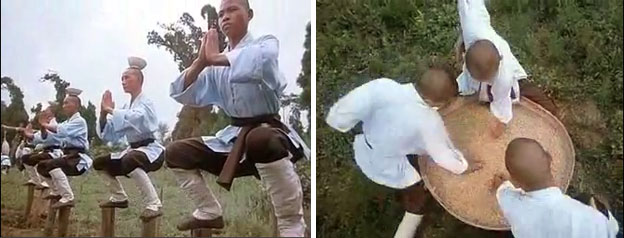
The Shaolin continued developing techniques through the centuries that helped not only develop a strong body but a sharp mind as well. Intense focus was required for training. The monks had to develop ways of controlling pain during long sessions. Qigong came in handy as the breathing techniques helped with pain management and focus. Monks would be expected to balance in a wide stance four hours on end or stab their fingertips into gravel. This helped develop stamina and strong legs for kicking as well as mighty calluses and dense bones for powerful punches. Meditation was used during these activities to help the monks counter the physical discomfort. The repetitive nature of these activities would form neural pathways in the brain, developing muscle memory. Monks could go through the motions blindfolded, in a trance-like state and focus instead on uniting the mind and body.
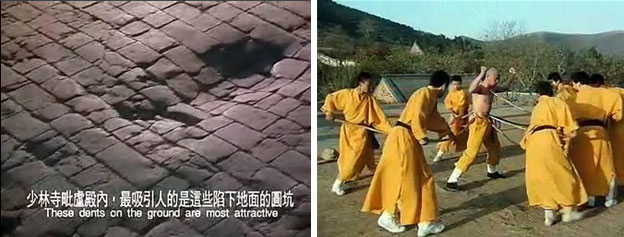
A strong body and absolute resolve were the things that gave birth to the legendary fighters. These were people said to be able to increase their density so that opponents could not lift or throw them. These were persons that could allegedly repel any weapon with their bare skin. There were many instances in manga and games where the main characters were seeing performing impossible feats of strength. These things were actually inspired by the training techniques of the kung-fu masters.

Some Shaolin practitioners focused on a particular skill, taking a lifetime to master the technique. Some might have a greatly developed palm strike due to "hard" training on their bones and tendons while another might use "soft" training to focus their chi on the palm during a strike and achieve the same effect. In wuxia stories the best fighters had mastered the external as well as internal arts. Those like Yuxia Tie illustrated above from the comic book The Four Constables had earned the name "Iron Hands" In the comics he could stop any weapon attack with his bare hands. His hands and arms were forged by punching through boiling oil, iron sand and glacial ice until they were as powerful as iron. This physical strength was enhanced by the internal chi training he received from his master Zhuge. The sharpest sword could not inflict any harm to him because he had mastered both internal as well as external conditioning in the comics. These external and internal techniques were made popular in many wuxia stories. The places that the masters studied and trained were so revered that they too became immortalized in popular media. What person in the world has not at least heard of the Shaolin?
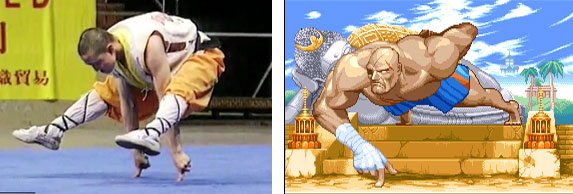
Popular culture was inspired by the fables of the martial artists. They took the true stories of combatants, assassins and warriors and began building fantasies around these fighters. At first there were literary adventures. Some stories were utterly impossible, serving more like classic Greek literature. They were parables on living well and fearing the gods. As the media changed the legends were retold in illustrated formats and eventually reached the 20th century in comic book and film formats. The stem of the impossible was rooted in some sense of reality. The Shaolin and other kung-fu schools developed a great deal of the material which creators drew from. According to legend mastery of qigong meant that practitioners were able to train even while asleep. Monks were known for being able to sleep while sitting up, sitting on their heads or even while suspended on ropes. These physical acts made the practitioners appear weightless and in absolute control of both their conscious and unconscious mind.
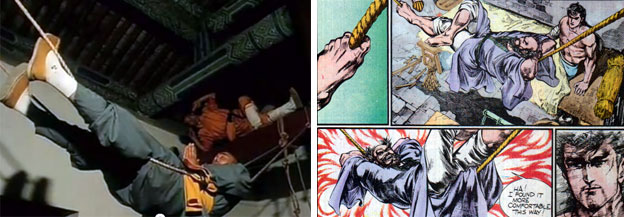
The idea of weightlessness gave precedence to the tales of assassins that were able to run on water and evade capture from even the greatest sentry. Historians would say that in ancient times the Japanese ninja were able to use pontoons to run across ponds or rivers. In the dark of night these pontoons would appear invisible. Shaolin practitioners were able to recreate similar feats using thin pieces of wood strung end to end. With enough speed a great sense of balance and of course practice they could get almost 100 feet across a body of water before momentum and gravity brought them down. Kung-fu fighters that were proficient at kicking and the other arts that required legwork were said to be masters of the "Light Foot" techniques.
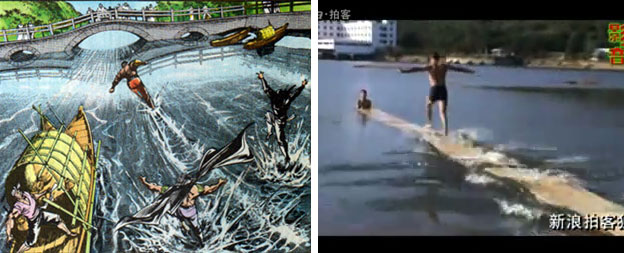
In time the light foot techniques became the basis of a myth. Warriors that had tremendous light foot skills were said to be able to run on water, balance on treetops, leap across narrow rooftops or do anything else that only birds could have. Hong Kong cinema began putting these legends on the big screen. They created a genre of fighting film with a heavy emphasis on wire work. Harnesses that allowed actors to fly across the screen had become almost commonplace in action cinema since it was introduced more than a half-century ago. There was much more to the legends than what was seen in the films. The things that separated the masters from the myths had inspired the development of the fighting game archetypes. In popular culture the iconography of the Shaolin, locations and forms of kung fu would be explored again and again. In fighting games some of the cues were very subtle and some were very overt. Yet the Shaolin and the Buddhists were not the only figures that spawned the characters featured in fighting games. Some characters were based on historical figures and others on mythological creatures. The next blog will look at some of these crossover characters. As always if you enjoyed this blog and would like to sponsor me please visit my Patreon page and consider donating each month, even as little as $1 would help make better blogs and even podcasts!

No comments:
Post a Comment